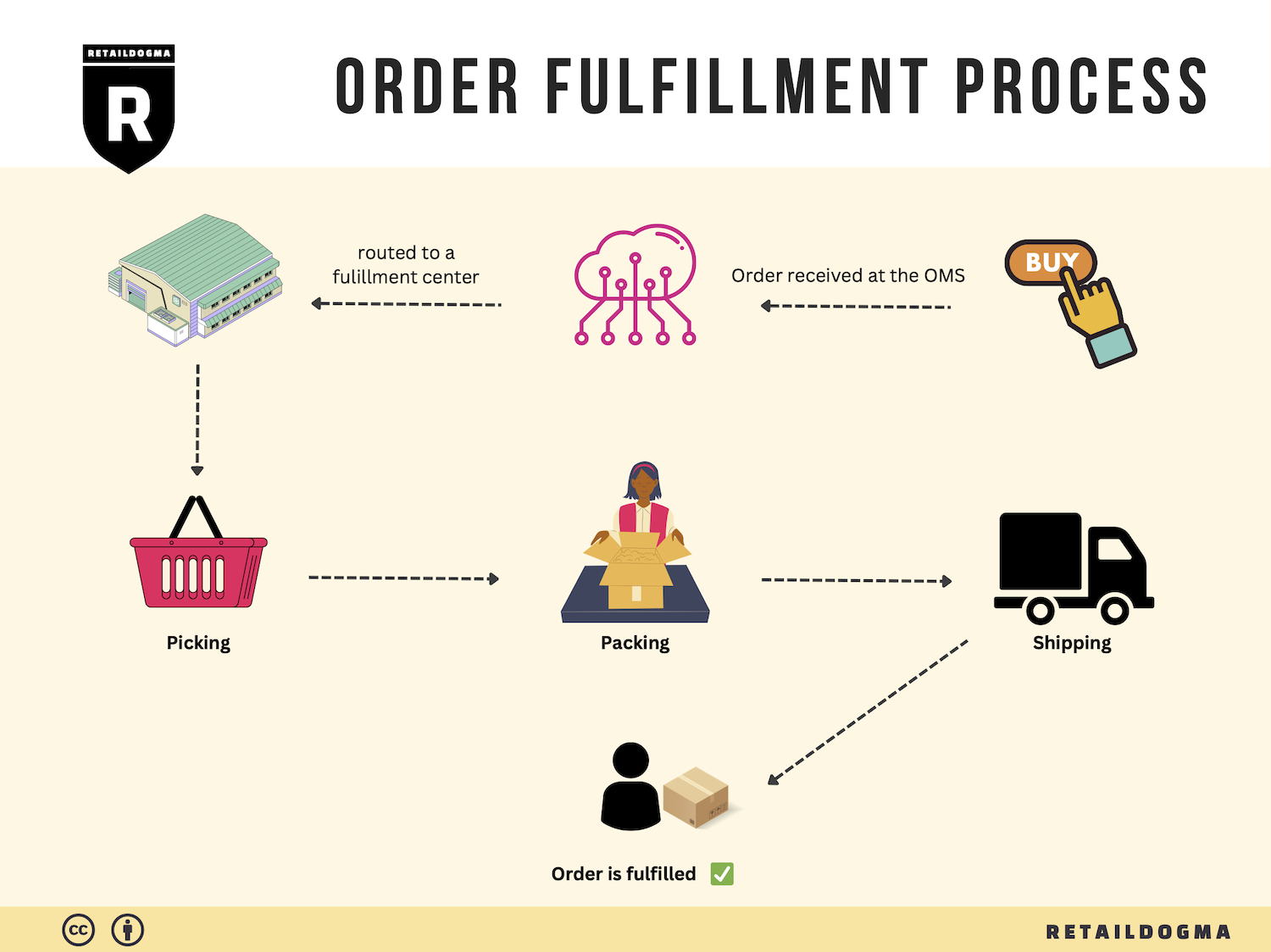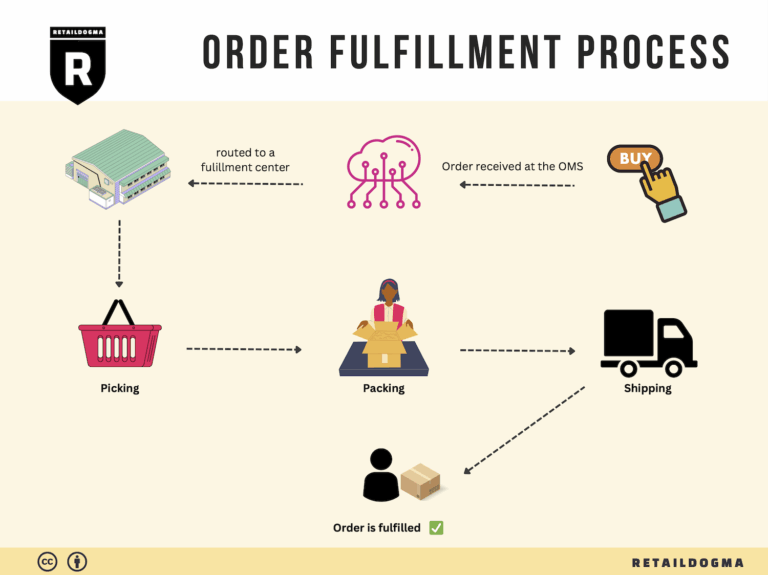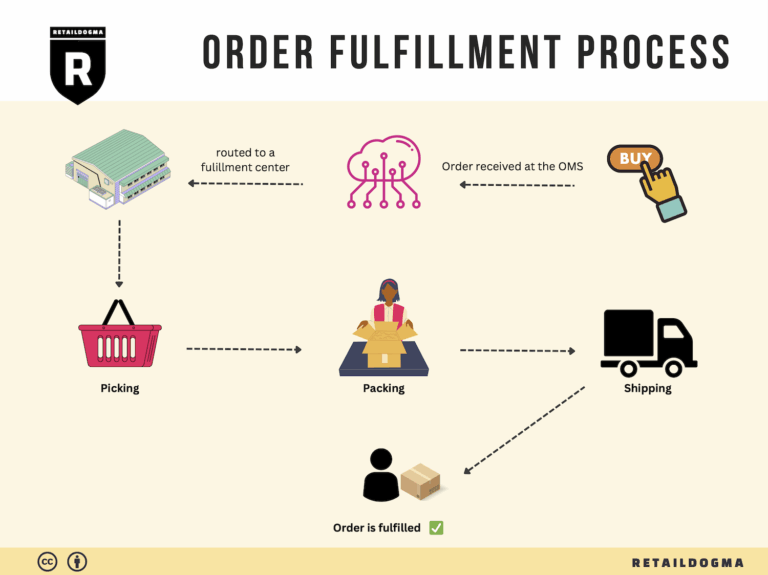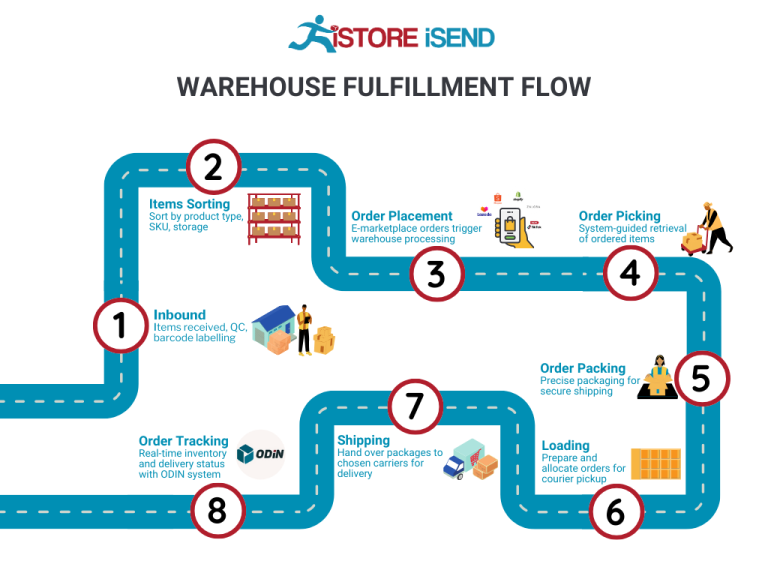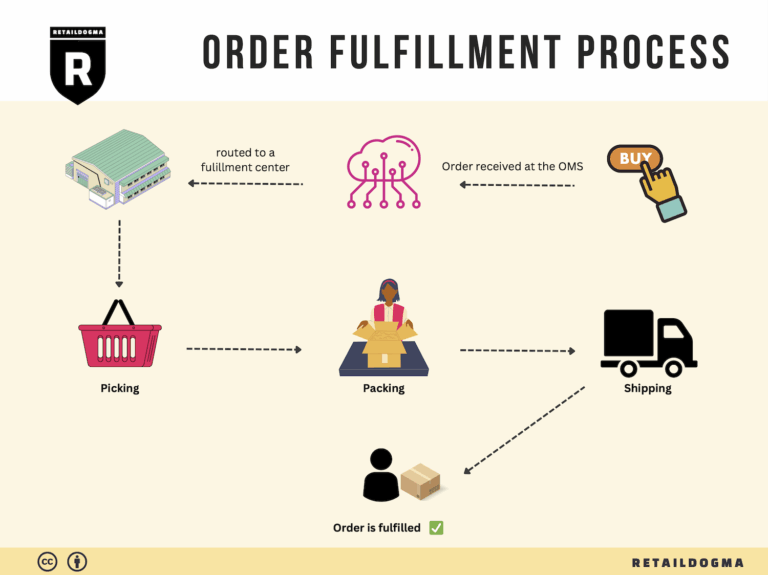How Order Fulfillment Works: A Step-by-Step Guide for Businesses
What is E-commerce Fulfillment? An Introduction for Growing Businesses
As your e-commerce business begins to grow, the excitement of increasing sales can quickly turn into the stress of managing logistics. Many entrepreneurs find themselves overwhelmed with the demands of packing and shipping orders, leaving little time for other critical aspects of their business, such as marketing and customer engagement. This is where e-commerce fulfillment comes into play.
Understanding E-commerce Fulfillment
E-commerce fulfillment refers to the entire process of getting a product from your inventory to your customer’s doorstep. It encompasses everything from receiving orders and managing inventory to picking, packing, and shipping products. For growing businesses, having an efficient fulfillment strategy is essential not only for maintaining customer satisfaction but also for scaling operations effectively.
What This Guide Covers
In this guide, we will explore various fulfillment models that can help you optimize your logistics as your business expands. We will discuss:
-
Fulfillment Models: Understanding the differences between Third-Party Logistics (3PL), Fulfillment by Amazon (FBA), and other fulfillment options. Each model has its own advantages and disadvantages, and choosing the right one can significantly impact your operational efficiency.
-
Core Services: We will break down the essential services offered by fulfillment partners, including inventory management, order processing, shipping, return handling, and more. Knowing what services are available will help you align your needs with the right provider.
-
Choosing a Partner: Selecting the right fulfillment partner is crucial for your business’s success. We’ll provide practical tips on what to look for in a partner, including experience, technology integration, customer service, and scalability.
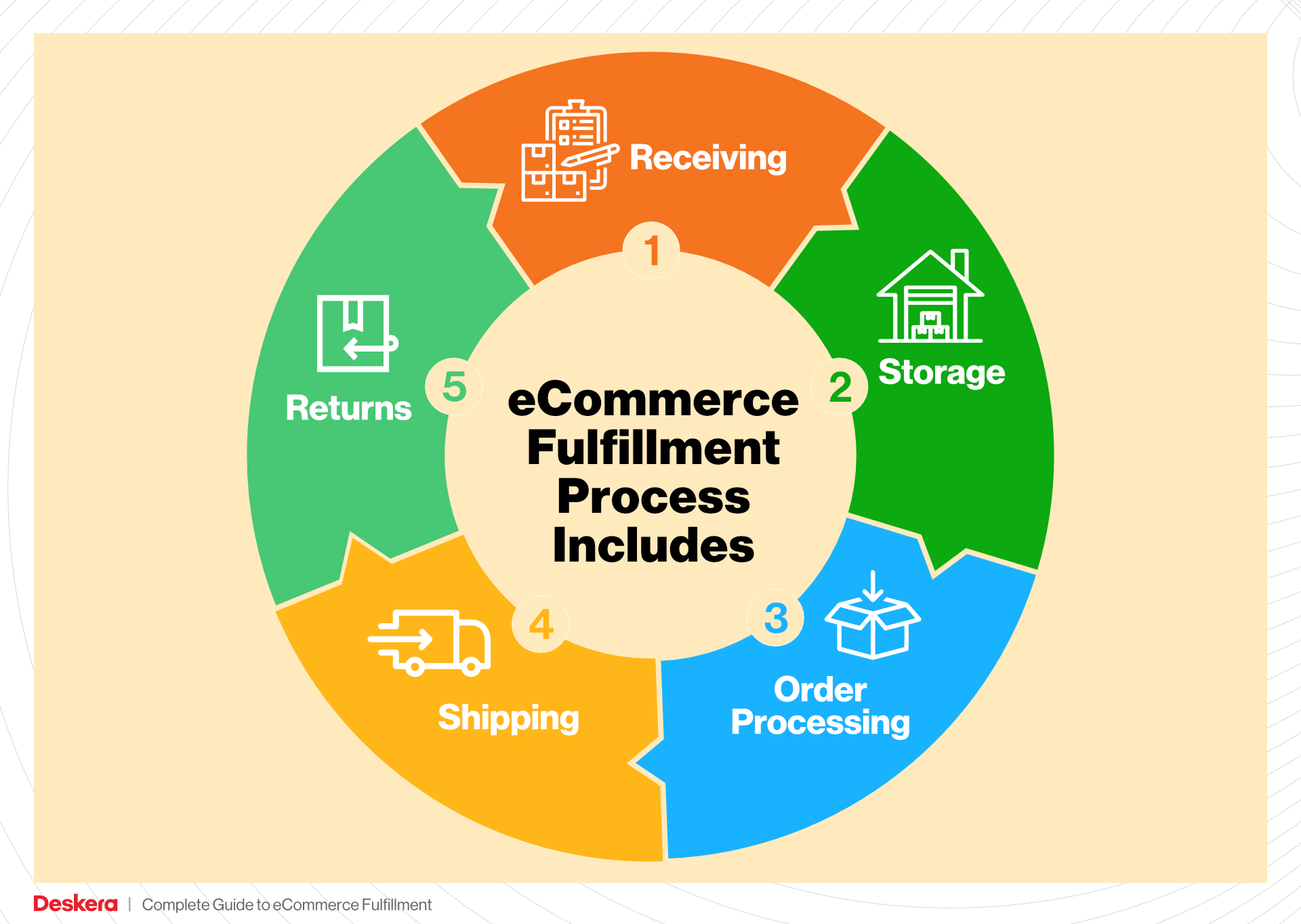
-
Pricing Structures: Fulfillment costs can vary widely based on services, storage, and shipping methods. We’ll outline common pricing structures and provide insights on how to budget for these expenses without compromising on quality.
Empowering Smart Decisions
Ultimately, this guide aims to empower you as a business owner or operations manager to make informed decisions about your logistics. By understanding the complexities of e-commerce fulfillment and the options available to you, you can streamline your operations, reduce costs, and enhance the overall customer experience. This will not only free up your time to focus on growing your business but also help you scale fearlessly in a competitive landscape. Let’s dive in and explore how effective fulfillment can transform your e-commerce operations.
What You’ll Learn In This Guide
- What is E-commerce Fulfillment? An Introduction for Growing Businesses
- The Order Fulfillment Process: From ‘Buy’ Button to Customer’s Door
- Comparing Fulfillment Models: In-House vs. 3PL vs. Dropshipping
- A Deep Dive into Amazon FBA: Pros, Cons, and Who It’s For
- Core Services Offered by Fulfillment Centers
- How to Choose a Fulfillment Partner: A 6-Point Checklist
- Understanding Fulfillment Pricing: A Breakdown of Common Fees
- Frequently Asked Questions (FAQs) about Fulfillment
- Conclusion: Is Outsourcing Fulfillment the Right Move for Your Business?
- Important Disclaimer
The Order Fulfillment Process: From ‘Buy’ Button to Customer’s Door
1. Receiving Inventory
The order fulfillment process begins with receiving inventory from suppliers or manufacturers. When products arrive at the fulfillment center, they must be checked for accuracy against purchase orders and inspected for any damages. This step is crucial because it ensures that the inventory is correct and in good condition before it is stored.
Key Term: SKU (Stock Keeping Unit)
Each product is assigned a unique SKU, which helps in tracking inventory levels and managing stock efficiently. This systematic approach to receiving inventory not only streamlines the process but also minimizes the risk of errors that could lead to stock discrepancies later on. By maintaining accurate inventory records from the start, businesses can ensure they have the right products available when customers place orders.
2. Warehouse Storage
Once the inventory is received and processed, it is stored in the fulfillment center’s warehouse. Effective storage solutions are vital for maximizing space and ensuring easy access to products. Items may be organized based on various factors such as size, type, or frequency of sale.
Key Term: FIFO (First In, First Out)
The FIFO method is commonly used in warehouse storage to ensure that older stock is sold before newer stock. This is particularly important for perishable goods or products with expiration dates. Proper warehouse management not only aids in maintaining product quality but also enhances the overall efficiency of the fulfillment process, making it easier to locate items quickly when orders come in.
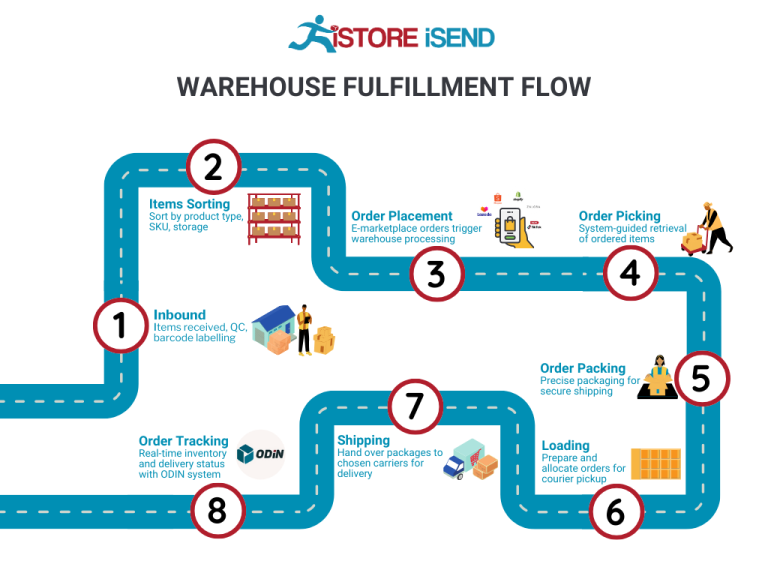
3. Order Picking
When a customer places an order, the next step is order picking, where warehouse staff retrieve the items from storage. This process typically involves generating a pick list, which outlines the items that need to be collected for each order.
Key Term: Pick List
A pick list is essential for guiding staff through the warehouse and ensuring that the correct items are selected. Efficient order picking is critical for maintaining fast order processing times and high customer satisfaction. Modern fulfillment centers often employ various picking methods, such as batch picking or zone picking, to streamline this process further and reduce the time spent locating and retrieving products.
4. Order Packing
After the items are picked, they move to the packing station, where they are prepared for shipment. During this stage, products are carefully packed to prevent damage during transit, and packing materials, such as bubble wrap and branded boxes, may be used to enhance the unboxing experience for customers.
Key Term: Packing Slip
A packing slip is included in each package, detailing the items inside and serving as a confirmation for the customer. This step is vital not only for protecting the products but also for reinforcing brand identity through thoughtful presentation. Proper packing helps minimize returns due to damage and improves overall customer satisfaction.

5. Shipping & Delivery
The final step in the order fulfillment process is shipping and delivery. Once packages are packed, they are labeled and handed over to shipping carriers for delivery to the customer. This stage involves selecting the most efficient shipping methods and tracking shipments until they reach their destination.
Key Term: Shipping Carrier
Shipping carriers, such as USPS, UPS, and FedEx, play a significant role in ensuring timely and reliable delivery. Choosing the right carrier and shipping options can significantly impact shipping costs and delivery times, which are crucial for customer satisfaction. Additionally, providing customers with tracking information allows them to monitor their orders, enhancing transparency and trust in the fulfillment process.
By understanding and optimizing each step of the order fulfillment process, e-commerce businesses can enhance their operational efficiency, reduce costs, and ultimately improve customer satisfaction. Implementing best practices in inventory management, warehouse storage, order picking, packing, and shipping will lay a solid foundation for scaling your business effectively.
Comparing Fulfillment Models: In-House vs. 3PL vs. Dropshipping
Fulfillment Models Comparison
| Model | Who Handles Inventory | Best For (Business Stage) | Key Advantage | Key Disadvantage |
|---|---|---|---|---|
| In-House Fulfillment | The business itself | Startups to established businesses | Full control over inventory and processes | High overhead costs and resource-intensive |
| Third-Party Logistics (3PL) | A third-party provider | Growing businesses | Scalability and expertise in logistics | Less control over inventory and processes |
| Dropshipping | Suppliers or manufacturers | New or small businesses | Low startup costs and no inventory risk | Lower profit margins and potential quality control issues |
In-House Fulfillment
In-house fulfillment refers to the process where a business manages its entire logistics operation, including warehousing, inventory management, order picking, packing, and shipping. This model is often favored by startups and established businesses that seek complete control over their inventory and fulfillment processes. One of the significant advantages of in-house fulfillment is the ability to maintain brand integrity and customer experience. Businesses can ensure that their products are handled according to their standards, from the moment they are picked to when they reach the customer’s doorstep. However, this model comes with its challenges. It requires significant investment in warehousing space, technology, and staffing, which can lead to high overhead costs. Additionally, managing logistics in-house can be resource-intensive, taking focus away from core business functions like product development and marketing.
Third-Party Logistics (3PL)
Third-party logistics (3PL) involves outsourcing fulfillment operations to a specialized logistics provider. This model is ideal for growing businesses that need to scale their operations without the burden of managing logistics internally. A key advantage of 3PL is the expertise that comes from working with established providers who have extensive experience in logistics, warehousing, and shipping. They often have robust systems in place, allowing businesses to benefit from efficiencies, lower shipping costs, and faster delivery times. Furthermore, 3PL providers typically offer flexible solutions, such as no long-term contracts and scalable services tailored to the business’s evolving needs. However, the downside is that businesses relinquish some control over their inventory and fulfillment processes, which can lead to challenges in maintaining brand consistency and customer satisfaction. Businesses must carefully choose a 3PL partner to ensure that they align with their values and operational standards.
Dropshipping
Dropshipping is a fulfillment model where businesses sell products without holding any inventory. Instead, when a customer places an order, the business purchases the item from a third-party supplier, who then ships it directly to the customer. This model is particularly attractive for new or small businesses as it requires minimal startup costs and eliminates the risk of overstocking or inventory management. With dropshipping, entrepreneurs can quickly test new products and pivot their offerings based on market demand without the financial burden of upfront inventory costs. However, dropshipping comes with its own set of challenges. Businesses often face lower profit margins due to reliance on suppliers for pricing and shipping. Additionally, they have less control over product quality and fulfillment timelines, which can negatively impact customer experience. Managing supplier relationships and ensuring timely deliveries can also be complex, leading to potential disruptions in service.
Conclusion
Choosing the right fulfillment model depends on the specific needs and stage of your business. In-house fulfillment provides control but can be costly and resource-intensive. Third-party logistics (3PL) offer scalability and expertise, making it suitable for growing businesses, while dropshipping presents a low-risk entry point for newcomers but with challenges in quality control and margins. Understanding the strengths and weaknesses of each model is crucial for e-commerce business owners and operations managers aiming to scale their sales and logistics effectively.
A Deep Dive into Amazon FBA: Pros, Cons, and Who It’s For
Understanding Fulfillment by Amazon (FBA)
Fulfillment by Amazon (FBA) is a service provided by Amazon that allows sellers to store their products in Amazon’s fulfillment centers. Amazon then takes care of storage, packaging, shipping, and customer service on behalf of the sellers. This service enables businesses to leverage Amazon’s vast logistics network and customer base, making it easier to reach potential customers and streamline operations.
How FBA Works
-
Set Up Your FBA Account: Sellers need to create an Amazon Seller account and enroll in FBA. This involves providing essential business information and linking your bank account for payouts.
-
Prepare Your Inventory: Before sending products to Amazon, sellers must prepare their inventory according to Amazon’s guidelines. This includes labeling products correctly and ensuring they meet packaging standards.
-
Ship Your Products to Amazon: Once prepared, sellers ship their inventory to Amazon’s fulfillment centers. Amazon provides shipping plans to streamline this process.
-
Amazon Takes Over: After products arrive at the fulfillment centers, Amazon handles storage, order processing, packaging, and shipping. When a customer places an order, Amazon picks the product, packs it, and ships it directly to the customer.
-
Customer Service and Returns: Amazon also manages customer service inquiries and returns, providing a seamless experience for buyers. This includes handling refunds and processing returned items.
-
Tracking and Reporting: Sellers can monitor their inventory, sales, and performance metrics through the Amazon Seller Central dashboard.
Pros of Using FBA
1. Prime Eligibility
One of the most significant advantages of FBA is that products become eligible for Amazon Prime, providing sellers access to millions of loyal Prime members. This can significantly boost sales, as Prime members tend to spend more and prefer products with fast shipping.
2. Customer Trust
Amazon is a recognized and trusted brand. By using FBA, sellers can benefit from this trust, as customers are more likely to purchase products fulfilled by Amazon due to the assurance of quality service and support.
3. Multi-Channel Fulfillment
FBA allows sellers to fulfill orders from various sales channels, not just Amazon. Whether selling on eBay, their own website, or other marketplaces, sellers can use FBA to manage their logistics, simplifying operations and providing consistent shipping experiences.
4. Scalability
FBA enables sellers to scale their businesses quickly without worrying about the complexities of warehousing and logistics. As sales increase, Amazon can handle the increased demand without requiring sellers to invest in additional infrastructure.
5. Time Savings
By outsourcing fulfillment to Amazon, sellers can focus on growing their business, such as marketing and product development, rather than spending time on logistics and order fulfillment.
Cons of Using FBA
1. High Fees
One of the primary drawbacks of FBA is the associated costs. Sellers incur various fees, including storage fees for keeping products in Amazon’s warehouses, fulfillment fees per unit sold, and additional charges for long-term storage. These fees can eat into profit margins, especially for low-cost items.
2. Strict Inventory Rules
Amazon has stringent inventory management policies that sellers must follow. This includes guidelines on labeling, packaging, and storage limits. Failure to comply can lead to additional fees or even account suspension, making it crucial for sellers to stay informed and adhere to these regulations.
3. Commingling Risks
FBA utilizes a commingling inventory system, meaning that products from different sellers can be stored together. While this can streamline operations, it poses a risk of receiving returns or damaged items that were not originally yours, potentially affecting your brand’s reputation.
4. Loss of Control
Using FBA means handing over significant control of your logistics to Amazon. Sellers must rely on Amazon’s processes and systems, which can lead to challenges if issues arise, such as delays or mismanagement of inventory.
5. Dependence on Amazon
FBA creates a dependency on Amazon’s platform. Changes in Amazon’s policies, fees, or algorithms can directly impact your business, making it essential to stay agile and ready to adapt.
Who is FBA Best For?
Fulfillment by Amazon is ideal for various types of sellers, particularly:
-
Small to Medium-Sized Businesses: Companies looking to scale quickly without investing heavily in logistics can benefit from FBA’s extensive infrastructure and resources.
-
E-commerce Entrepreneurs: New sellers or those testing the waters in e-commerce can leverage Amazon’s credibility and reach without the burden of managing logistics.
-
Retailers with Seasonal Products: Businesses that experience fluctuating demand, such as seasonal items, can use FBA to manage storage and fulfillment during peak times without long-term commitments.
-
Brands Focused on Growth: Companies aiming for rapid growth and willing to navigate the associated fees and risks can find FBA an effective way to increase visibility and sales.
In conclusion, while FBA offers numerous advantages, including access to Prime customers and simplified logistics, it’s essential for sellers to weigh these benefits against the potential downsides, such as high fees and loss of control. Understanding your business model and customer base will help determine if FBA is the right fulfillment solution for your e-commerce venture.
Core Services Offered by Fulfillment Centers
Inventory Management & Warehousing
Inventory management and warehousing are foundational services provided by fulfillment centers, essential for any e-commerce business aiming to scale efficiently. This service encompasses the storage, tracking, and organization of a business’s inventory in a secure facility. Fulfillment centers typically offer climate-controlled storage and advanced security measures, ensuring that products remain in optimal condition.
The benefits of effective inventory management are manifold. Firstly, it allows businesses to keep track of stock levels in real-time, minimizing the risk of stockouts or overstock situations. This is crucial for maintaining customer satisfaction; a well-stocked inventory ensures that orders are fulfilled promptly. Additionally, most fulfillment centers provide sophisticated inventory management systems that integrate seamlessly with e-commerce platforms, enabling automatic updates on stock levels and alerts for low inventory. This level of integration not only streamlines operations but also reduces manual errors, allowing business owners to focus on growth strategies rather than day-to-day logistics.
Pick and Pack Services
Pick and pack services are at the heart of fulfillment operations. This process involves selecting items from the warehouse based on customer orders (picking), and then assembling these items into a package for shipment (packing). Fulfillment centers employ trained personnel who ensure that each order is accurately picked and packed, often using efficient methods and technologies to enhance speed and accuracy.
The primary advantage of pick and pack services is the efficiency they bring to order fulfillment. By outsourcing this function to a specialized provider, e-commerce businesses can significantly reduce order processing times, which is a critical factor for customer satisfaction in today’s fast-paced market. Moreover, professional fulfillment centers often utilize advanced packing techniques to minimize shipping costs and reduce the risk of damage during transit. This attention to detail not only enhances the customer experience but also improves a business’s bottom line.
Kitting and Assembly
Kitting and assembly services involve the grouping of multiple products into a single package or kit, often for promotional purposes or to create bundled offers. This service can also include the assembly of products that require additional steps before they are ready for sale, such as assembling furniture or electronics.
The benefit of kitting and assembly services is twofold. Firstly, they allow businesses to offer unique product bundles that can attract more customers and encourage larger orders. For example, a business selling kitchen gadgets might offer a bundled kit that includes a knife, cutting board, and recipe book. This not only enhances the perceived value but can also simplify the shopping experience for customers. Secondly, by outsourcing kitting and assembly, businesses can save time and labor costs, allowing them to focus on core activities such as marketing and customer engagement.
Returns Management (Reverse Logistics)
Returns management, often referred to as reverse logistics, is an essential service provided by fulfillment centers. This process involves handling returned items efficiently and effectively, ensuring that products are inspected, restocked, or disposed of as necessary. A well-structured returns management system can significantly enhance customer satisfaction by making the return process straightforward and hassle-free.
The benefits of efficient returns management cannot be overstated. In e-commerce, where return rates can be as high as 30% for certain categories, having a robust system in place is crucial. Fulfillment centers typically offer streamlined processes for receiving returns, assessing the condition of returned items, and updating inventory accordingly. This not only keeps inventory levels accurate but also helps maintain customer trust. A seamless return experience can turn a potentially negative interaction into a positive one, encouraging customers to shop again in the future. Moreover, effective returns management can provide valuable insights into customer preferences and product quality, helping businesses refine their offerings.
Conclusion
In summary, the core services offered by fulfillment centers—inventory management and warehousing, pick and pack services, kitting and assembly, and returns management—are vital for e-commerce businesses looking to scale efficiently. By leveraging these services, businesses can optimize their logistics operations, enhance customer satisfaction, and ultimately drive growth. As e-commerce continues to evolve, partnering with a reliable fulfillment center can provide the competitive edge necessary to thrive in this dynamic marketplace.
How to Choose a Fulfillment Partner: A 6-Point Checklist
Location & Warehouse Network
Importance: The location of your fulfillment partner’s warehouses can significantly impact your shipping costs and delivery times. Proximity to your customer base can enhance service levels and reduce shipping expenses.
Questions to Ask:
– Where are your fulfillment centers located, and how many do you have?
– Can you provide shipping zone maps to help us understand delivery timelines and costs?
– How do you handle order fulfillment for international shipping?
– What are your policies for expanding your warehouse network as we grow?
Technology & Integrations
Importance: A robust technology platform is essential for seamless order management, inventory tracking, and reporting. It should integrate easily with your existing e-commerce platforms to ensure real-time data exchange.
Questions to Ask:
– What fulfillment management system do you use, and how does it integrate with popular e-commerce platforms?
– Can you provide real-time inventory tracking and reporting?
– How do you handle data security and compliance with regulations?
– Are there any costs associated with software integration or upgrades?
Specializations (e.g., cold storage, oversized items)
Importance: Depending on your product type, you may need a partner with specialized capabilities. Whether you require temperature-controlled storage for perishables or the ability to handle oversized items, it’s vital to ensure your fulfillment partner can meet these needs.
Questions to Ask:
– What types of products do you specialize in handling?
– Do you offer any specialized storage solutions (e.g., cold storage, hazardous materials)?
– How do you manage unique packing and shipping requirements for different product types?
– Can you provide case studies or examples of how you’ve successfully fulfilled orders for similar products?
Scalability & Capacity
Importance: As your business grows, your fulfillment needs will change. It’s crucial to choose a partner that can scale with you, whether you experience seasonal spikes in demand or long-term growth.
Questions to Ask:
– How do you handle increased order volumes during peak seasons?
– What is your current capacity, and how do you plan to expand as demand grows?
– Can you provide examples of how you’ve supported other clients during periods of rapid growth?
– Are there any limits on the types or volumes of orders you can fulfill for us?
Pricing and Contracts
Importance: Understanding the pricing structure and contract terms is essential for maintaining profitability. You need a partner whose costs align with your budget and who offers transparent pricing without hidden fees.
Questions to Ask:
– What is your pricing model (e.g., per order, per item, storage fees)?
– Are there any additional fees we should be aware of (e.g., setup, integration, storage)?
– What are the terms of your contracts? Is there flexibility to adjust as our needs change?
– How do you handle billing disputes or discrepancies?
Customer Support & Reviews
Importance: Exceptional customer support is a hallmark of a reliable fulfillment partner. You want a partner who is responsive and proactive in addressing your needs and concerns.
Questions to Ask:
– What level of customer support do you provide (e.g., dedicated account manager, 24/7 support)?
– How do you handle communication during order fulfillment issues or delays?
– Can you provide references or testimonials from current clients?
– What are your customer satisfaction metrics, and how do you measure success?
Conclusion
Choosing the right fulfillment partner is a critical decision that can impact your e-commerce business’s efficiency, customer satisfaction, and overall success. By carefully evaluating potential partners against this checklist, you can make an informed choice that aligns with your operational needs and growth ambitions. Remember to prioritize open communication and transparency throughout the selection process to establish a strong foundation for a successful partnership.
Understanding Fulfillment Pricing: A Breakdown of Common Fees
Initial Setup Fees
Initial setup fees are often the first cost you encounter when partnering with a fulfillment center. These fees cover the administrative work required to onboard your business, including account creation, system integration, and any necessary training.
Typically, setup fees can range from a few hundred to several thousand dollars, depending on the complexity of your operations and the fulfillment provider’s infrastructure. Some providers may waive these fees, especially if they focus on small businesses or startups, to foster long-term relationships. When evaluating fulfillment centers, inquire specifically about their policy on initial setup fees to avoid unexpected costs.
Receiving Fees
Receiving fees are charged when your inventory arrives at the fulfillment center. This fee compensates the provider for the labor involved in unloading, inspecting, and entering your products into their inventory management system.
The calculation of receiving fees is generally based on the volume or weight of the incoming shipment. Some fulfillment centers charge a flat fee per pallet or box, while others may have tiered pricing depending on the total quantity. For businesses shipping in bulk, it’s essential to understand how these fees will impact your overall logistics costs and to negotiate favorable terms where possible.
Storage Fees (per pallet/bin)
Storage fees are a recurring cost that covers the space your inventory occupies within the fulfillment center. This fee can be charged monthly or quarterly and is usually calculated based on the amount of space your products take up, either by the pallet or by bin.
Typically, storage fees range from $10 to $50 per pallet per month, while bin storage can vary widely based on the provider’s pricing structure. It’s important to consider how quickly you turn over inventory; slow-moving products can lead to higher storage costs. Some fulfillment centers may also offer free storage for a limited time or during promotional periods, which can be advantageous for seasonal businesses.
Pick & Pack Fees (per item/order)
Pick and pack fees are charged for the labor involved in selecting items from inventory and preparing them for shipment. This process includes picking the correct items, packing them securely, and labeling them for delivery.
These fees are typically charged per item or per order, with costs ranging from $0.20 to $2.00 per item depending on the complexity of the packing requirements. For example, kitting or custom packaging may incur higher fees. Understanding how these fees are structured will help you estimate fulfillment costs accurately, especially if your product range varies significantly in size and handling requirements.
Shipping Fees
Shipping fees encompass the costs associated with transporting your products from the fulfillment center to your customers. These fees can vary greatly based on factors such as package dimensions, weight, destination, and shipping method (standard, expedited, international, etc.).
Fulfillment centers often have partnerships with major carriers, which can lead to discounted shipping rates. It’s essential to assess how these shipping fees fit into your overall pricing strategy. Some centers may offer flat-rate shipping options, while others may pass on the exact shipping costs to you. Be sure to discuss shipping options and potential savings with your fulfillment partner to optimize your logistics expenses.
Tips for Getting an Accurate Quote
To ensure you receive an accurate quote from potential fulfillment partners, consider the following tips:
-
Provide Detailed Information: Share specifics about your product dimensions, weights, and anticipated order volumes. The more information you provide, the more accurate your quote will be.
-
Ask About All Fees: Inquire about all possible fees, including hidden ones, to avoid surprises down the line. Request a breakdown of each fee type to understand how they are calculated.
-
Negotiate Terms: Don’t hesitate to negotiate terms, especially if you anticipate high order volumes or long-term partnerships. Some fulfillment centers may offer discounts or special rates for loyal customers.
-
Review Contract Terms: Carefully review the contract for any clauses related to fee increases or additional charges. Understanding the terms will help you manage costs effectively over time.
-
Consider Seasonal Variations: If your business experiences seasonal fluctuations, discuss how these will affect pricing. Some fulfillment centers may offer flexible pricing structures to accommodate seasonal spikes in order volume.
By taking these steps, you can ensure that you select a fulfillment partner that not only meets your operational needs but also aligns with your budgetary constraints, ultimately supporting your business growth.
Frequently Asked Questions (FAQs) about Fulfillment
1. What is a fulfillment center?
A fulfillment center is a third-party logistics (3PL) facility that stores, picks, packs, and ships products on behalf of e-commerce businesses. It serves as a centralized location where inventory is managed, enabling businesses to outsource their logistics and focus on growth.
2. What’s the difference between a warehouse and a fulfillment center?
While both warehouses and fulfillment centers store products, their functions differ significantly. A warehouse primarily serves as a storage space for inventory, often with minimal operational activities. In contrast, a fulfillment center is designed for order processing, including picking, packing, and shipping directly to customers, thus playing a crucial role in the e-commerce supply chain.
3. What is a 3PL?
A Third-Party Logistics provider (3PL) is a company that offers logistics and supply chain management services to businesses. This includes warehousing, inventory management, order fulfillment, shipping, and returns handling. Partnering with a 3PL allows small businesses to leverage expert logistics capabilities without investing in their own infrastructure.
4. How much do fulfillment services cost?
Fulfillment service costs can vary widely based on several factors, including the volume of orders, the complexity of the services provided (such as kitting or custom packaging), storage needs, and shipping destinations. On average, businesses may expect to pay a monthly storage fee per cubic foot of inventory, along with fees for order processing, picking, packing, and shipping. It’s essential to obtain quotes from multiple providers to understand the pricing structure that best fits your business model.
5. What services do fulfillment centers typically offer?
Fulfillment centers generally provide a range of services, including:
– Inventory Storage: Secure storage for products.
– Order Processing: Picking, packing, and shipping orders directly to customers.
– Returns Management: Handling returns and restocking items.
– Inventory Management: Real-time tracking and reporting of stock levels.
– Shipping Services: Partnering with carriers for efficient shipping solutions.
6. How do I choose the right fulfillment center for my business?
Selecting the right fulfillment center involves assessing several key factors:
– Location: Proximity to your customer base can reduce shipping times and costs.
– Services Offered: Ensure the center provides the specific services you need, such as kitting or international shipping.
– Technology Integration: Look for centers that offer seamless integration with your e-commerce platform for real-time tracking and inventory management.
– Pricing Structure: Understand their fee structure and any additional costs that may arise.
– Customer Support: Evaluate their responsiveness and the level of support they provide.
7. How can fulfillment services help scale my business?
Fulfillment services can significantly enhance scalability by allowing you to focus on core business activities while outsourcing logistics. With a reliable fulfillment partner, you can:
– Increase order capacity without investing in additional infrastructure.
– Improve shipping efficiency and customer satisfaction.
– Access advanced inventory management tools and analytics.
– Expand into new markets with ease, thanks to established shipping networks.
8. What should I know about shipping with a fulfillment center?
When working with a fulfillment center, consider the following:
– Carrier Partnerships: Many fulfillment centers collaborate with major carriers to offer competitive shipping rates.
– Shipping Speed: A fulfillment center’s location can impact delivery times; choose one that is strategically located near your target customers.
– International Shipping: If you plan to sell globally, ensure your fulfillment partner has experience with international shipping regulations and logistics.
9. What is the process for getting started with a fulfillment center?
To get started with a fulfillment center, follow these steps:
1. Research Providers: Identify potential fulfillment centers that meet your needs.
2. Request Quotes: Obtain quotes to compare pricing and services.
3. Review Contracts: Carefully read and understand the terms, including fees and service levels.
4. Integrate Technology: Set up integration between your e-commerce platform and the fulfillment center’s systems.
5. Send Inventory: Ship your products to the fulfillment center and confirm they are received and stored correctly.
6. Launch Fulfillment: Begin processing orders through the fulfillment center and monitor performance.
10. How do fulfillment centers handle returns?
Fulfillment centers typically offer comprehensive returns management services. This includes:
– Receipt of Returns: Accepting returned products and logging them into the inventory system.
– Inspection: Checking returned items for quality and condition.
– Restocking: Updating inventory levels and restocking items for resale.
– Customer Communication: Providing updates to customers regarding the status of their returns.
Effective returns management is crucial for maintaining customer satisfaction and managing inventory accurately.
Conclusion: Is Outsourcing Fulfillment the Right Move for Your Business?
Key Benefits of Outsourcing Fulfillment
Outsourcing fulfillment can be a transformative move for your e-commerce business. By partnering with a reliable fulfillment service, you can save valuable time, allowing you to concentrate on strategic activities like marketing, product development, and customer engagement. This time savings can lead to more efficient operations and ultimately, higher sales.
Moreover, outsourcing provides significant scalability. As your business grows, your fulfillment partner can seamlessly adjust to increased order volumes without the headache of managing additional warehouse space or hiring new staff. This flexibility is crucial for navigating peak seasons and unexpected sales surges, ensuring that your customers receive their orders promptly, which is vital for maintaining satisfaction and loyalty.
In addition to time and scalability, choosing the right fulfillment partner means leveraging their expertise. Established fulfillment services come with industry knowledge, advanced technology, and best practices that can enhance your logistics operations. They can help you optimize shipping costs, streamline inventory management, and improve order accuracy—elements that are fundamental to a thriving e-commerce business.
Choosing the Right Partner for Growth
However, the benefits of outsourcing fulfillment hinge on selecting the right partner. A poor choice can lead to inefficiencies and customer dissatisfaction, undermining your business’s growth. It’s essential to research potential partners thoroughly, considering their technology, customer service, and track record with businesses similar to yours.
Next Steps
Take a moment to audit your current shipping and fulfillment processes. Are they meeting your business’s demands? Are you experiencing delays or errors that could impact customer satisfaction? If the answer is yes, it may be time to consider a fulfillment partner. Start by reaching out to potential 3PL providers for quotes and consultations. This strategic move could be the catalyst that propels your e-commerce business to new heights.
Important Disclaimer
⚠️ Important Disclaimer
The information in this guide is for educational purposes. Fulfillment services, pricing, and platform features change frequently. Always conduct your own due diligence and consult with providers directly before making business decisions.
